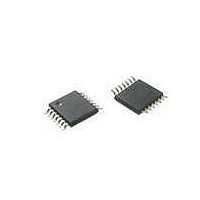ATTINY20-XU Atmel, ATTINY20-XU Datasheet - Page 145

ATTINY20-XU
Manufacturer Part Number
ATTINY20-XU
Description
MCU AVR 2KB FLASH 12MHZ 14TSSOP
Manufacturer
Atmel
Series
AVR® ATtinyr
Datasheet
1.ATTINY20-EK1.pdf
(224 pages)
Specifications of ATTINY20-XU
Core Processor
AVR
Core Size
8-Bit
Speed
12MHz
Connectivity
I²C, SPI
Peripherals
Brown-out Detect/Reset, POR, PWM, WDT
Number Of I /o
12
Program Memory Size
2KB (1K x 16)
Program Memory Type
FLASH
Ram Size
128 x 8
Voltage - Supply (vcc/vdd)
1.8 V ~ 5.5 V
Data Converters
A/D 8x10b
Oscillator Type
Internal
Operating Temperature
-40°C ~ 85°C
Package / Case
*
Processor Series
ATtiny
Core
AVR
Data Bus Width
8 bit
Data Ram Size
128 B
Interface Type
SPI, TWI
Maximum Clock Frequency
12 MHz
Number Of Programmable I/os
12
Number Of Timers
2
Operating Supply Voltage
3.3 V
Maximum Operating Temperature
+ 85 C
Mounting Style
SMD/SMT
Minimum Operating Temperature
- 40 C
Operating Temperature Range
- 40 C to + 85 C
Lead Free Status / RoHS Status
Lead free / RoHS Compliant
Eeprom Size
-
Lead Free Status / Rohs Status
Details
Available stocks
Company
Part Number
Manufacturer
Quantity
Price
Company:
Part Number:
ATTINY20-XU
Manufacturer:
Atmel
Quantity:
904
- Current page: 145 of 224
- Download datasheet (6Mb)
17.4.1
17.4.1.1
8235B–AVR–04/11
Receiving Address Packets
Case 1: Address packet accepted - Direction bit set
TWI interrupt, or be used for polled operation. There are dedicated status flags for indicating
ACK/NACK received, clock hold, collision, bus error and read/write direction.
When an interrupt flag is set, the SCL line is forced low. This will give the slave time to respond
or handle any data, and will in most cases require software interaction.
TWI slave operation. The diamond shapes symbols (SW) indicate where software interaction is
required.
Figure 17-11. TWI Slave Operation
The number of interrupts generated is kept at a minimum by automatic handling of most condi-
tions. Quick Command can be enabled to auto trigger operations and reduce software
complexity.
Promiscuous Mode can be enabled to allow the slave to respond to all received addresses.
When the TWI slave is properly configured, it will wait for a START condition to be detected.
When this happens, the successive address byte will be received and checked by the address
match logic, and the slave will ACK the correct address. If the received address is not a match,
the slave will not acknowledge the address and wait for a new START condition.
The slave Address/Stop Interrupt Flag is set when a START condition succeeded by a valid
address packet is detected. A general call address will also set the interrupt flag.
A START condition immediately followed by a STOP condition, is an illegal operation and the
Bus Error flag is set.
The R/W Direction flag reflects the direction bit received with the address. This can be read by
software to determine the type of operation currently in progress.
Depending on the R/W direction bit and bus condition one of four distinct cases (1 to 4) arises
following the address packet. The different cases must be handled in software.
If the R/W Direction flag is set, this indicates a master read operation. The SCL line is forced
low, stretching the bus clock. If ACK is sent by the slave, the slave hardware will set the Data
Interrupt Flag indicating data is needed for transmit. If NACK is sent by the slave, the slave will
wait for a new START condition and address match.
Figure
17-11. shows the
ATtiny20
145
Related parts for ATTINY20-XU
Image
Part Number
Description
Manufacturer
Datasheet
Request
R

Part Number:
Description:
IC, MCU, 8BIT, 2K FLASH, 20SOIC
Manufacturer:
Atmel
Datasheet:

Part Number:
Description:
IC, MCU, 8BIT, 2K FLASH, 20PDIP
Manufacturer:
Atmel
Datasheet:

Part Number:
Description:
IC, MCU, 8BIT, 8K FLASH, 20PDIP
Manufacturer:
Atmel
Datasheet:

Part Number:
Description:
IC, MCU, 8BIT, 8K FLASH, 20SOIC
Manufacturer:
Atmel
Datasheet:

Part Number:
Description:
DEV KIT FOR AVR/AVR32
Manufacturer:
Atmel
Datasheet:

Part Number:
Description:
INTERVAL AND WIPE/WASH WIPER CONTROL IC WITH DELAY
Manufacturer:
ATMEL Corporation
Datasheet:

Part Number:
Description:
Low-Voltage Voice-Switched IC for Hands-Free Operation
Manufacturer:
ATMEL Corporation
Datasheet:

Part Number:
Description:
MONOLITHIC INTEGRATED FEATUREPHONE CIRCUIT
Manufacturer:
ATMEL Corporation
Datasheet:

Part Number:
Description:
AM-FM Receiver IC U4255BM-M
Manufacturer:
ATMEL Corporation
Datasheet:

Part Number:
Description:
Monolithic Integrated Feature Phone Circuit
Manufacturer:
ATMEL Corporation
Datasheet:

Part Number:
Description:
Multistandard Video-IF and Quasi Parallel Sound Processing
Manufacturer:
ATMEL Corporation
Datasheet:

Part Number:
Description:
High-performance EE PLD
Manufacturer:
ATMEL Corporation
Datasheet:











